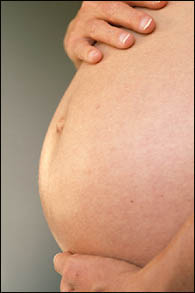Rough ride for ice storm babies
Rough ride for ice storm babies McGill University
User Tools (skip):
Tough Ride for ice storm babies
There's the old cliché about making lemonade when life hands you lemons.
Facing stress and inconvenience herself during the 1998 ice storm, Dr Suzanne King, an associate professor in McGill's Department of Psychiatry, saw a rare opportunity.
During the ice storm, King was busy - her husband was away at a conference, she needed to place her two young children somewhere where there was electricity, her mother-in-law, recovering from a broken hip, was staying with King, and King was emptying out sump pumps.
"I was running back and forth and I realized all my interests were going away from anything intellectual and right down to basics like water, shelter, warmth," King told an audience attending a Joint Departments of Epidemiology and Biostatistics and Occupational Health seminar series last Thursday.

PHOTO: Eyewire |
|
"I found that I was quite stressed. And it gave me the idea that this was an opportunity to study firsthand those thousands of women out there who were also stressed but were pregnant at the same time."
King says Project Ice Storm offers a chance to answer questions other studies on prenatal stress haven't been able to address.
"Project Ice Storm is the only study that I'm aware of which is taking an event which is relatively randomly assigned to women, which is very distressful," says King. "To get those women while they were still pregnant, to find out their kinds of attributions about the storm, measure their hormones and follow these women through birth, through infancy and through childhood."
The study focuses on one of Quebec's worst affected areas during the ice storm, an agricultural section of the South Shore known as the Montérégie.
In June 1998, King arranged for doctors at four area hospitals to send mail-in questionnaires to women who were pregnant during the ice storm or who became pregnant within three months after it ended. Of the first 1,440 questionnaires, King received only 224 responses.
"This study is not a good epidemiological study of the effects of the ice storm on women in the Montérégie," King concedes. But the study will help King, a senior research fellow at the Douglas Hospital Research Centre, learn more about how prenatal stress affects women and their children.
To measure the objective severity of the women's exposure to the ice storm, women were asked questions about what happened to them.
Were they or anyone close to them injured or did they feel they were in danger? Did they experience any loss of income or damage? Did their families stay together? Did they stay in a shelter? How crowded was it where they stayed? How many days were they without electricity?
A general health questionnaire measured levels of depression, anxiety, sleep patterns and general functioning, and included questions aimed at detecting post-partum depression and post-traumatic stress disorder. The questionnaires included kits allowing women to measure their levels of cortisol, a stress hormone.
A second questionnaire sent six months after the women's due dates asked about the outcome of the pregnancy, including obstetrical complications, and about the babies' characteristics at birth.
A select group of 75 families took part in a laboratory assessment of the children when they were two years old.
On average, during the ice storm the women had spent 15 days without electricity and four days without a phone. As well, an influenza outbreak affected all four hospitals, adding to the stress.
Preliminary findings suggest the ice storm affected children's physical, cognitive and behavioural development.
King found that second semester exposure to the storm was often linked to shorter gestational length, prematurity and lower birth weight.
And the greater the stress during the storm, the smaller the babies were at birth. Women reporting at least one obstetric complication experienced higher feelings of threat during the storm, showed post-traumatic stress symptoms and had significantly more severe depression and anxiety symptoms during the pregnancy.
The ice storm may have played a role in children's temperaments. The greater the number of days without electricity during the pregnancy, the more "dull" the mother rated the baby at six months.
Higher levels of maternal cortisol during the pregnancy were associated with babies scoring higher for difficultness, inadaptability and dullness. Having had a maternal cold or flu while pregnant was associated with fussy babies needing more attention. And babies whose mothers experienced higher ice storm stress and whose mothers had a cold or flu were rated as the most difficult.
Of the children brought into the laboratory at age two and tested using the Bayley Scales of Development, those whose mothers experienced moderate to high levels of ice storm stress had significantly lower IQ scores than children of mothers in the low-stress group. And this effect was greatest in children exposed to the ice storm during the second trimester - their mothers reported they recognized and spoke fewer words than other children their age.
Until about six months ago, King says the study had virtually "no money." Now a one-year, $50,000 grant from the Canadian Psychiatric Research Foundation (CIBC World Markets Children's Miracle Award) is allowing researchers to follow up with 150 families through mail surveys and to further analyze the data.
King says she'll continue to pursue funding. "We'll follow the kids until we see no more effects of prenatal stress."

